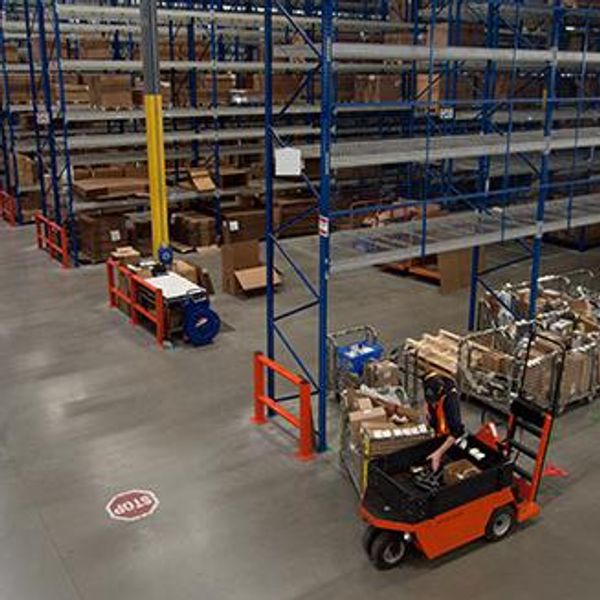Warehouse Design Solutions
A Smarter Warehouse

Efficient warehouse design is the foundation of an efficient supply chain, one that can service your customers in a timely fashion. When warehouse design doesn't evolve with regular or unexpected changes in operations, products or personnel, it can leave your whole supply chain languishing.
Penske Logistics designs streamlined warehouse layouts that are built for the most efficient access to goods and overall execution of labor within your warehouse. Team up with us to implement a data-driven warehouse design strategy that will maximize your performance inside and set you up for success outside your distribution centers.
Technology-Driven Modeling
Every warehouse has its idiosyncrasies. We work with businesses all over the world to make the most of their square footage, and minimize the risks that can hinder warehouse operations.
You have to know what you're working with and what you're working toward to design and implement the perfect warehouse layout. Some of the research we perform to influence good warehouse design is related to:
- Facility location and size analysis
- Capacity analysis
- Equipment analysis
- Cross-dock layout and scheduling
- Facility simulation modeling
- Process flow analysis
- Labor and material-handling equipment utilization
- Operational engineering and process development
Backed by data, you can design a warehouse to address all of these variables affecting operations. You'll find that strategic warehouse designs influence efficiency in all your processes, from inventory control to production tactics and labor management.
Making the Most of Your Space, Every Day
Penske's warehouse designs help make the most of the space you already have. Our experts keep up with your business to create designs that ensure efficient material handling and economical storage, while protecting the safety of people and product. Moreover, the designs we implement ensure facilities can be modified to accommodate changing needs without major expense or disruption. Keep Penske Logistics in your back pocket—we're working for your continuous improvement.
7 Common Questions About Warehouse Design
What is warehouse design?
Efficient warehouse design is the foundation of an efficient supply chain, one that can service your customers in a timely fashion. It is the physical layout and placement of products for the most efficient movement of goods.
Why is warehouse design important?
The right warehouse layout should help to improve the flow of production and distribution and make the most of your budget. A well-designed warehouse layout also enables better administration of the workforce, procedures, and inventory.
What are the various factors to be considered in warehouse design?
When designing a warehouse, there are many things to consider. Some of the most impactful factors include:
- The goods and products the facility is designed to hold
- The physical characteristics of the building
- The required equipment that is necessary to operate the warehouse
- The circulation of goods throughout the facility
What are the different types of warehouse design?
There are three main types of warehouse design: U-shaped, I-shaped and L-shaped.
The most typical layout is a U-shaped warehouse product flow. Due to the proximity of the shipping and receiving ports in this arrangement, resources at the dock, including workers and material handling equipment, can be pooled. Additionally, this arrangement reduces product handling and provides great cross-docking capability.
The I-shaped warehouse takes advantage of the two ends of the warehouse layout and uses them as the loading and unloading areas. The longer center section of the I is used as the picking, packing, and receiving areas as well as general storage areas providing ample space for the warehouse.
The U-shaped warehouse keeps everything apart and streamlines inventory flow. The U-shape also aids in preventing bottlenecks by having incoming and leaving shipments on parallel sides. Workers can move goods between shipping and receiving quickly because they are located on the same side of the building.
What is product flow in a warehouse?
Product flow is the movement of goods throughout the warehouse designed to get the products from supplier to consumer. Products are often classified using the ABC analysis.
A movers typically represent products that have the most turnover and as result, they are of strategic importance. A goods are typically placed in the lower areas of a warehouse, with direct and easy access for the operators, and close to the shipping docks.
B movers are often these goods which are replenished more slowly, and their value and importance are less than those of A products.
B SKUs carry importance because they could make the move to A-turnover products or, conversely, become C goods. B products are located in intermediate-height areas. They can’t be accessed as directly as A products, but they are also not inaccessible either.
Products that are identified as C movers are typically the most least requested products by customers. Since these items are not in high demand, they are touched very infrequently and therefore occupy the highest locations and the distances furthest away from the dock.
Which warehouse design is the most commonly used for product flow?
For product flow, the most typical layout is a U-shaped warehouse. Due to the proximity of the shipping and receiving docks, dock resources including manpower and material handling equipment can be used jointly in this layout.
What are the objectives of warehouse design?
Effective warehouse design improves operational effectiveness, cuts costs, and raises customer satisfaction. Utilizing resources wisely while satisfying customer expectations is the primary objective of successful warehouse design.